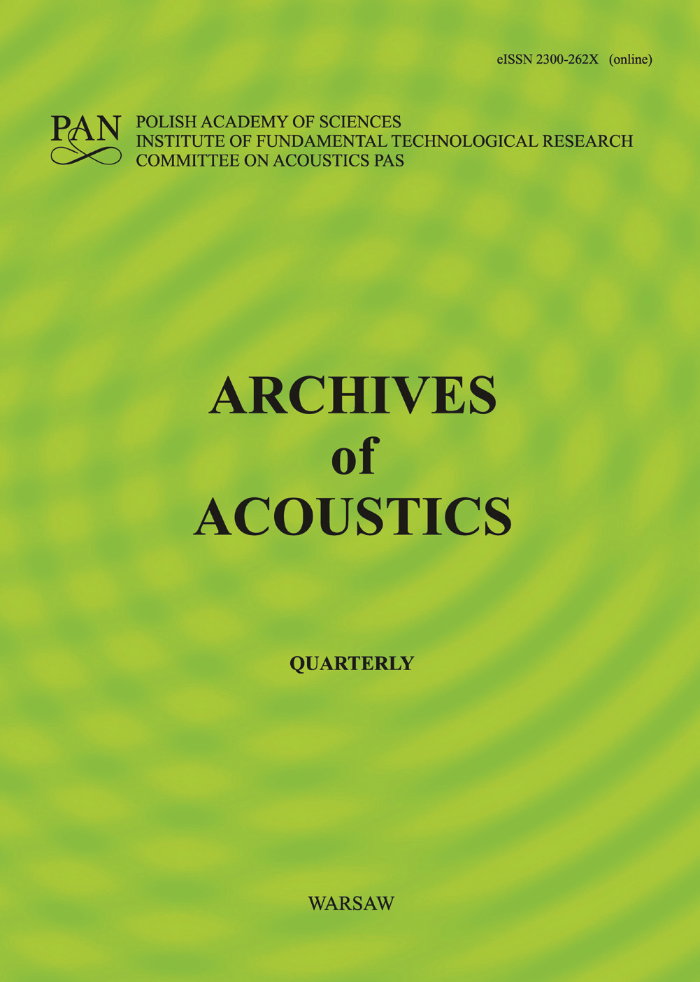Abstract
Switching to renewable energy has been accelerated in recent decades due to the depleting fossil fuel reserves and the need to mitigate environmental and climate degradation. Wind power, especially in urban areas, has seen a significant growth. A critical consideration in the urban wind turbine installation is the noise impact on residents. This study investigates the noise generated by wind turbines under different operational conditions, comparing single-segment and five-segment rotor designs. Various acoustic analyses were conducted, including broadband analysis with weighting curves Z, A, C, and G, a narrowband analysis using 1/12 octave bands, and broadband calculations of sound quality indicators such as sharpness, roughness, and fluctuation strength (FS). The FS was also examined in the Bark scale frequency domain. The study linked the acoustic analysis with the rotor efficiency related to power production. The findings indicate that five-segment rotors generate less acoustic energy due to phase shifts, enhancing dissipation rates, and acoustic energy decreases with the increasing load, peaking when rotors are free at high revolutions per minute (RPM). While single-segment rotors show higher efficiency, they produce more noise. In contrast, five-segment rotors offer a better sound quality, making them preferable despite a lower efficiency. This research provides essential insights into designing urban wind turbines that balance efficiency and noise, crucial for sustainable energy solutions.Keywords:
wind power, wind turbines, rotor efficiency, Savonius rotor segmentationReferences
- Abbasi M. et al. (2019), Assessment of role of job components and individual parameters on the raised blood pressure in a noisy industry, Archives of Acoustics, 44(3): 575–584, https://doi.org/10.24425/aoa.2019.129272.
- Akwa J.V., Vielmo H.A., Petry A.P. (2012), A review on the performance of Savonius wind turbines, Renewable and Sustainable Energy Reviews, 16(5): 3054–3064, https://doi.org/10.1016/j.rser.2012.02.056.
- Anjum S., Kumari A. (2022), Evaluation of noise pollution in Bengaluru City, India during COVID-19 pandemic, Archives of Acoustics, 47(2): 131–140, https://doi.org/10.24425/aoa.2022.141644.
- Blauert J. (2005), Communication Acoustics, Springer, https://doi.org/10.1007/b139075.
- Cox T. (n.d.), Roughness – Fluctuation Strength, https://hub.salford.ac.uk/sirc-acoustics/psychoacoustics/sound-quality-making-products-sound-better/an-introduction-to-sound-quality-testing/roughness-fluctuation-strength/. (access: 27.03.2024).
- Davy J.L., Burgemeister K., Hillman D. (2018), Wind turbine sound limits: Current status and recommendations based on mitigating noise annoyance, Applied Acoustics, 140: 288–295, https://doi.org/10.1016/j.apacoust.2018.06.009.
- Deshmukh S., Bhattacharya S., Jain A., Paul A.R. (2019), Wind turbine noise and its mitigation techniques: A review, Energy Procedia, 160: 633–640, https://doi.org/10.1016/j.egypro.2019.02.215.
- Doerffer K., Telega J., Doerffer P., Hercel P., Tomporowski A. (2021), Dependence of power characteristics on Savonius rotor segmentation, Energies, 14(10): 2912, https://doi.org/10.3390/en14102912.
- Driss Z., Mlayeh O., Driss D., Maaloul M., Abid M.S. (2014), Numerical simulation and experimental validation of the turbulent flow around a small incurved Savonius wind rotor, Energy, 74: 506–517, https://doi.org/10.1016/j.energy.2014.07.016.
- Dumitrescu H., Cardos V., Dumitrache A., Frunzulica F. (2010), Low-frequency noise prediction of vertical axis wind turbines, [in:] Proceedings of the Romanian Academy – Series A: Mathematics, Physics, Technical Sciences, Information Science, 11(1): 47–54.
- Fastl H., Zwicker E. (2007), Psychoacoustics: Facts and Models, Springer Berlin, Heidelberg, 3rd ed., pp. 203–238, https://doi.org/10.1007/978-3-540-68888-4.
- Flaszynski P., Piotrowicz M., Bacci T. (2021), Clocking and potential effects in combustor–turbine stator interactions, Aerospace, 8(10): 285, https://doi.org/10.3390/aerospace8100285.
- Gallo P., Fredianelli L., Palazzuoli D., Licitra G., Fidecaro F. (2016), A procedure for the assessment of wind turbine noise, Applied Acoustics, 114: 213–217, https://doi.org/10.1016/j.apacoust.2016.07.025.
- Ghasemian M., Nejat A. (2015), Aerodynamic noise prediction of a horizontal axis wind turbine using improved delayed detached Eddy simulation and acoustic analogy, Energy Conversion and Management, 99: 210–220, https://doi.org/10.1016/j.enconman.2015.04.011.
- Graham W., Pearson C. (2022), Noise from a model-scale vertical-axis wind turbine, AIAA Journal, 60(1): 224–235, https://doi.org/10.2514/1.J060531.
- Grzelak J., Carrillo L. G., Nakielski J., Piotrowicz M., Doerffer K. (2024), An innovative floating system with a Savonius rotor as a horizontal-axis wind turbine, Polish Maritime Research, 31(2): 13–19, https://doi.org/10.2478/pomr-2024-0017.
- Hafke-Dys H.Z., Preis A., Kaczmarek T., Biniakowski A., Kleka P. (2016), Noise annoyance caused by amplitude modulated sounds resembling the main characteristics of temporal wind turbine noise, Archives of Acoustics, 41(2): 221–232, https://doi.org/10.1515/aoa-2016-0022.
- Hansen C., Hansen K. (2020), Recent advances in wind turbine noise research, Acoustics, 2(1): 172–207, https://doi.org/10.3390/acoustics2010013.
- IBIS Power (n.d.), Complicated sustainability issues in real estate, solved beautifully and easily, https://www.ibispower.eu/powernest. (access: 27.03.2024).
- Iida A., Mizuno A., Fukudome K. (2004), Numerical simulation of aerodynamic noise radiated form vertical axis wind turbines, [in:] Proceedings of the 18 International Congress on Acoustics.
- Jeong M.-S., Kim S.-W., Lee I., Yoo S.-J., Park K.C. (2014), Investigation of wake effects on aeroelastic responses of horizontal-axis wind-turbines, AIAA Journal, 52(6): 1133–1144, https://doi.org/10.2514/1.J051899.
- Kacprzak K., Liskiewicz G., Sobczak K. (2013), Numerical investigation of conventional and modified Savonius wind turbines, Renewable Energy, 60: 578–585, https://doi.org/10.1016/j.renene.2013.06.009.
- Kotus J., Kostek B. (2008), The noise-induced harmful effect assessment based on the properties of the human hearing system, Archives of Acoustics, 33(4): 435–440.
- Mahmoud N., El-Haroun A.A.,Wahba E., Nasef M.H. (2012), An experimental study on improvement of Savonius rotor performance, Alexandria Engineering Journal, 51(1): 19–25, https://doi.org/10.1016/j.aej.2012.07.003.
- Mathew J., Singh A., Madsen J., Arce Leon C. (2016), Serration design methodology for wind turbine noise reduction, Journal of Physics: Conference Series, 753(2): 022019, https://doi.org/10.1088/1742-6596/753/2/022019.
- Mollerstrom E., Larsson S., Ottermo F., Hylander J., Baath L. (2014), Noise propagation from a vertical axis wind turbine, [in:] Proceedings of 43rd International Congress on Noise Control Engineering: Internoise 2014 .
- Moreau D.J., Doolan C.J. (2013), Noise-reduction mechanism of a flat-plate serrated trailing edge, AIAA Journal, 51(10): 2513–2522, https://doi.org/10.2514/1.J052436.
- Munzel T., Schmidt F.P., Steven S., Herzog J., Daiber A., Sorensen M. (2018), Environmental noise and the cardiovascular system, Journal of the American College of Cardiology, 71(6): 688–697, https://doi.org/10.1016/j.jacc.2017.12.015.
- New World Wind (n.d.), WindTree, https://www.newworldwind.com/windtree. (accessed: 27.03.2024).
- Nguyen D.P., Hansen K., Zajamsek B., Catcheside P. (2020), Evaluation of wind farm noise amplitude modulation synthesis quality, Applied Acoustics, 166: 107349, https://doi.org/10.1016/j.apacoust.2020.107349.
- Oerlemans S., Fuglsang P. (2012), Low-noise wind turbine design, Siemens AG, https://www.ewea.org/events/workshops/wp-content/uploads/2012/12/EWEANoise-Workshop-Oxford-2012-1-1-Stefan-Oerlemans.pdf. (access: 27.03.2024).
- Oerlemans S., Fisher M., Maeder T., Kogler K. (2009), Reduction of wind turbine noise using optimized airfoils and trailing-edge serrations, AIAA Journal, 47(6): 1470–1481, https://doi.org/10.2514/1.38888.
- Pawlaczyk-Łuszczyńska M., Dudarewicz A., Zaborowski K., Zamojska-Daniszewska M., Waszkowska M. (2014), Annoyance related to wind turbine noise, Archives of Acoustics, 39(1): 89–102, https://doi.org/10.2478/aoa-2014-0010.
- Pearson C.E., Graham W.R. (2014), Experimental characterization of vertical-axis wind turbine noise, The Journal of the Acoustical Society of America, 137(1): EL111–EL116, https://doi.org/10.1121/1.4904915.
- Sachar S., Doerffer P., Flaszynski P., Kotus J., Doerffer K., Grzelak J. (2023), Correlation between the generated noise and effectiveness for a vertical axis Savonius type rotor, [in:] AIAA SCITECH 2023 Forum, https://doi.org/10.2514/6.2023-0611.
- Sahai A.K. (2016), Consideration of aircraft noise annoyance during conceptual aircraft design, Ph.D. Thesis, RWTH Aachen University.
- Sun X., Luo D., Huang D., Wu G. (2012), Numerical study on coupling effects among multiple Savonius turbines, Journal of Renewable and Sustainable Energy, 4(5): 053107, https://doi.org/10.1063/1.4754438.
- Suresh T., Flaszynski P., Carpio A.R., Kurowski M., Piotrowicz M., Szulc O. (2024), Aeroacoustic effect of boundary layer separation control by rod vortex generators on the DU96-W-180 airfoil, Journal of Fluids and Structures, 127: 104133, https://doi.org/10.1016/j.jfluidstructs.2024.104133.
- Szychowska M., Hafke-Dys H., Preis A., Kociński J., Kleka P. (2018), The influence of audio-visual interactions on the annoyance ratings for wind turbines, Applied Acoustics, 129: 190–203, https://doi.org/10.1016/j.apacoust.2017.08.003.
- van den Berg G. (2004), Effects of the wind profile at night on wind turbine sound, Journal of Sound and Vibration, 277(4–5): 955–970, https://doi.org/10.1016/j.jsv.2003.09.050.
- van der Velden W.C., Oerlemans S. (2017), Numerical study on combed teeth serrations for wind turbine noise reduction, [in:] 23rd AIAA/CEAS Aeroacoustics Conference, https://doi.org/10.2514/6.2017-4172.
- Zare S., Ghotbiravandi M.R., Elahishirvan H., Ahsaeed M.G., Rostami M., Esmaeili R. (2020), Modeling and predicting the changes in hearing loss of workers with the use of a neural network data mining algorithm: A field study, Archives of Acoustics, 45(2): 303–311, https://doi.org/10.24425/aoa.2020.133150.







